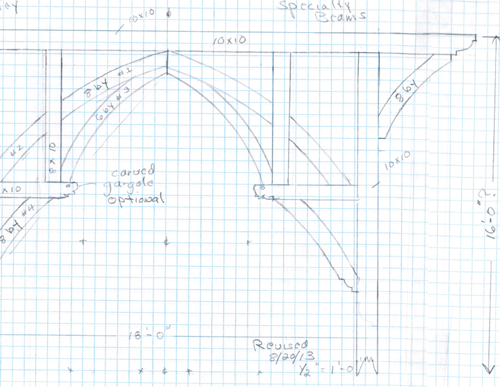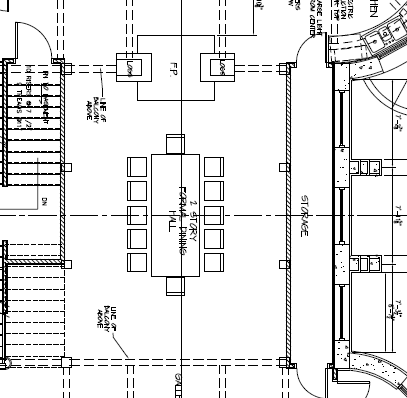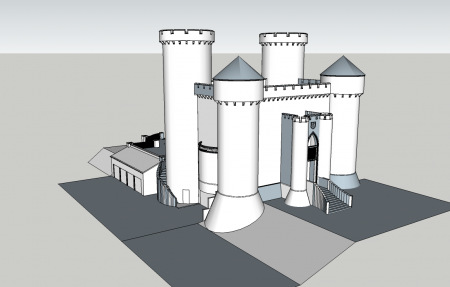Every castle has to have a great hall, a tall ceiling room with a roaring fireplace and a large table. My castle is no exception. In more contemporary architecture the great hall, still found in a wide variety of homes, is built with a sloped roof, and there are no certainly no floors above it, the hall simply has a ceiling as high as the structure in which it sits, be that commonly two stories, or rarely three stores. So while the timber framed great hall look is prevalent in many homes, of different styles and types (log homes or lodges especially), the trusses used to frame the ceiling (ostensibly to support the roof, but they’re often not structural, merely decorative) are peaked. This was not going to work for me.
The central square of my castle is 3 stories high, my great hall will only have a two story roof. The floor system we’re using between floors is a steel system that takes up two feet, my first floor has 12 foot ceilings, the other floors 10 foot ceilings, so that makes the overall ceiling height in my great room 24 feet, but it has a flat ceiling, so I needed to come up with a truss design for a flat ceiling.
Easy right? You just make an upside down U, problem solved. Sure, that’d work, but I wanted something fancier. I know that timber framing has a function, but I find it beautiful, evocative of a different era. And indeed in times past much artistic creativity was spent on these structural features, because they were so evident and obvious and would be looked at for decades if not centuries.
Being at this dream for years, I had reviewed many truss designs online and in books, and I knew I liked curved beams. I knew, of course, they would be expensive, but curves are special, on a woman, and on a house. I’m a fan of work like Gaudí’s, though it wouldn’t be appropriate for my castle to incorporate his stylings. I like arches and domes and vaulted ceilings and round windows and curves. My eyes were always drawn to trusses with curved elements, and I wanted to pursue that. But how?
I went through many iterations of what exactly I wanted, one small curved cross piece, curved corbels, and then I hit upon existing work that I loved and decided to copy. This was later, when it solidified that the castle would be gothic, and I started to specifically look for gothic style trusses. I found ones I loved.
Westminster Hall, which is today part of the British Parliament compound, was build in 1097 by the son of William the Conqueror (true story, according to Ancestry.com he may be a very distant relation, in as much as you can trust thousand year old information). It features gothic trusses which I really liked.

As you can see though, the ceiling is sloped, so I had to edit them slightly.
Then, could I afford it? My kitchen, being in a round tower, is going to feature a round ceiling beam. My architect had gotten that quoted at a place that would laminate and bend the wood, it was more than my car. Yeoch! I got a quote from Specialty Beams out of Montana, who claim to have big saws and other equipment exclusive to the country and are able to manufacturer big curved beams. They’ve got quite a gallery on their site, and have even supplied beams to Disney World. They wouldn’t do it as one round beam, rather in sections, with each joining area hidden with a corbel, on which they could carve a gothic face (think gargoyle, though they’re called grotesques, not gargoyles, when not used as waterspouts off a roof), which I had requested. Price? Much much more realistic.
So, I sent them my beam idea for quoting and I recently got it back. I need two trusses and it is going to cost me about $4000 per truss, which seems reasonable to me. These are big wood timbers, the biggest being 10x10s, and they’ll be finished with a hand scraped finish to make them look old. They can also add a couple more gargoyle faces for me. Here is what they came up with.
It might look a little funny with the side kickout, but then here is my great hall which may explain it:
So, I did something that is probably a little unique here, but it is an idea I had years and years ago and it always stuck with me. If you’ve read my other blog posts you know I’m trying to build a legitimate realistic castle, or as close enough as I can, and part of that means limiting windows and limiting them close to the ground. However I do not want to live in the dark so I’m putting in a center shaft with a large skylight to bring light to the interior. I also did not put any windows on the side of the building on the first floor, instead placing them high on the walls. I guess, similar to St Peter’s Basilica if you’ve been there. Certainly inspired by the high windows in cathedrals (I call them my cathedral windows). But then I realize that if my first floor is 12 feet and my second floor is 10, I can’t start windows at floor level, so at most I’d have 8 or 9 foot tall windows. That didn’t seem tall enough.
So you see little steps and a little ledge. The steps take you down to 8 feet over the first floor, if I then start my windows a foot or two above the floor of that ledge I have 14 foot tall windows. That seemed to be the scale I need. And indeed, looking at exterior elevations, anything shorter would have looked squat with the gothic arch top. So I’ll have big 14 feet windows, but they won’t start until around 18 feet off the ground on the exterior, which should hopefully maintain the defensive look I am after for authenticity. And if they don’t, well, it is on the side away from the road facing the forest, and I don’t know if the deer are architectural critics.
The plus side here is I get this long narrow storage closet. I mean, we all hate having to drag chairs up from the basement when we have a lot of people over for dinner right? Now imagine you’re in a castle and your basement storage area is quite far away because your house is so large. I knew I needed and wanted more storage near the kitchen and near the dining room, and this was an easy way to get it.
So, the great hall is actually the section framed by this little balcony, but on the second floor level the ceiling goes all the way to the exterior wall. Even though my trusses will not be structural, they need to look structural, or they will look funny (a good rule for these sorts of things, make things look like they’re needed). So the little side kickout “supports” the ceiling above the balcony near the cathedral windows.
On the exterior you see some buttresses, why? I wanted them, my wife has a fascination with buttresses (hardy har har) though she likes the flying ones you see on Notre Dame. Buttresses were an old way to stabilize walls from lateral forces. Much like the trusses on the interior keep the walls from falling in, the buttresses on the exterior keep the walls from falling out. Of course my building will be modern concrete & steel, the buttresses are not need, but they would have been used specifically in these places, between the high windows, to hold up this high otherwise flat wall, as seen in churches and cathedrals all over, so I wanted to include them. I have a thing for architectural details.



Hello i am working for the justice dept here in Ireland and we are interested in building a hall with room to hold 50+ people and to integrate into the design cob walls for a full Eco-sustainable building with all available technological systems for energy and waste management system, would this be in your field of expertise to provide technical support in drafting these type of drawings?
I’m just a homeowner Michael.
Hey there! I stumbled on your blog while researching castle-building; it’s been a dream of mine to build a castle to live in, and it’s so nice to see someone else that has achieved that dream.
That said, how did you go about the design process? Did you hire an architect? I googled “castle builders” with no luck at all (imagine that! hahaha). I’ve never designed a building, but I do have clear ideas about features and general style (like I definitely want Gothic influence in the design, etc). How did you go about finding an architect that was a) willing and b) able to deliver on this sort of unusual design?
I’d love to pick your brain! In the meantime, I’ll be catching up on your blog.
I had the broad strokes of the design in my head for years, and I used the consumer grade home design software to do some basic layouts, but honestly it sorta sucked for round walls and pen and paper would have worked better.
The architects of course had some good ideas on fitting stairs in (something I did not know how to calculate), and other things, but boy were they expensive, engineers too. You could build a decent house for what I paid in all of that.
If you went smaller, not as tall, you could do these things for less. I had to have engineers and whatnot because I went so big (4 stories put me under commercial codes in my jurisdiction). Also my clear spans inside are quite large. If you found a good builder, comfortable with wood framing, you could design a castle home together, frame with wood, and sheath in stone veneer. Don’t look for “castle builders” just find a builder. Also, if you can build in a county, rather than a city, you will have more flexibility. I was not so lucky.
I also like curved beams on trusses. Your example of Westminster Hall seems like a great image for curved timber trusses. I can see why you would want to use this image as an example for a new truss installed on your home, but without the steep slope. That would be a good way to make this more affordable and feasible to do when installing it on your house.